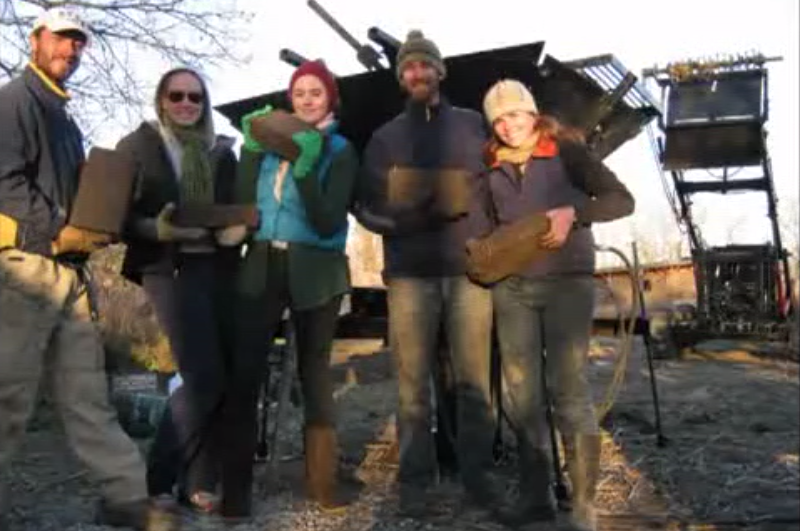The Global Village Construction Set is an open hardware initiative aimed at sharing tool-building knowledge. They believe that to build civilization you need forty basic tools, eight of which they’ve already prototyped and made available on their wiki. Included in these is a tractor which reminds us of a beefy bobcat. It has a soil pulverizing attachment which can be used to break down soil and feed it to their soil brick compressor. That machine spits out compressed dirt bricks which are used as building materials. They’re stacked on concrete footings and then limewashed to protect the un-baked bricks from water erosion. Does this remind anyone else of real-life Minecraft?
Above you can see a group of Open Source Ecology developers showing off bricks in front of the machine that made them, with the tractor/soil pulverizer to the right. Take a look at the videos about the construction set and brickmaking after the break. And learn more by perusing their weblog.
If you think an apocalypse is on the way you might want to buddy-up with these folks. They seem to know what they’re doing.
Global Village Construction Set
[vimeo=http://vimeo.com/16106427]
Building with soil
[vimeo=http://vimeo.com/16547692]
[Thanks Chris]
















Henry Ford created rubber tree plantations in South America. These soon failed due to blights that normally didn’t affect remotely spaced rubber trees. The Dutch had a policy in the Congo that if a man did not do his work they would cut off the hands of the female members of his family. To this day there are places in Africa where punishment is still the cutting off of hands. The French hired Native American mercenaries and told them to cut off the scalp of those white people they killed as proof so they would receive their pay. Yet in the history books it was the awful “savages” who took scalps with no mention of the French. The interaction of “1st” world with 3rd world often has undesirable outcome. However, this being said it is also usually those who have some quirky often misguided drive who are the only ones to get off their duff and actually do something while the rest are content to sit back and criticize and find fault, possibly thinking they are somehow justifying their inactivity by doing so.
Turning biomass into gas to burn to make heat to run a heat engine to drive a generator to run an induction furnace to heat steel seems a bit silly if they can simply gasify the biomass and use the gas to heat the crucible directly.
Homebrew MOSFETs, IGBTs or valves for the induction furnace would be impressive, nevertheless.
”Turning biomass into gas to burn to make heat to run a heat engine to drive a generator to run an induction furnace to heat steel seems a bit silly if they can simply gasify the biomass and use the gas to heat the crucible directly.”
Well, engineers who understand looses, efficiency, and the 2nd law of thermodynamics tend to stay put in the civilized world.
i meant to say losses
i have been following this forum and reading the comments that people have been making.
I live in africa and this is my personal opinion. Africa missed out on the horses and carriages age. Our industralization is poor. None the less we have rushed to very complicated technology which we can not develop locally hence, making us heavly dependent on the west machinery.
Africa needs to embrace light industralization. the making of basic machinery that is afordable and within our reach. We need to try as much as possible to manufacture our own machines and maintain them(Self sustainability). OSE is not perfect but brings us closer to this idea.
I agree to some degree the idea of using animals, but this is not effcient. The OSE machines are something that africa can work with. I believe that the pool of technicians africa has trained and the intriduction of such machines can provide employment spawn a new to type of industralicatio in africa.